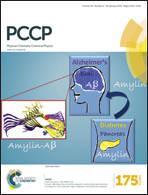Nb and Ta layer doping effects on the interfacial energetics and electronic properties of LaAlO3/SrTiO3 heterostructure: first-principles analysis†
Abstract
The two-dimensional electron gas (2DEG) formed at the n-type (LaO)+1/(TiO2)0 interface in the polar/nonpolar LaAlO3/SrTiO3 (LAO/STO) heterostructure (HS) has emerged as a prominent research area because of its great potential for nanoelectronic applications. Due to its practical implementation in devices, desired physical properties such as high charge carrier density and mobility are vital. In this respect, 4d and 5d transition metal doping near the interfacial region is expected to tailor electronic properties of the LAO/STO HS system effectively. Herein, we studied Nb and Ta-doping effects on the energetics, electronic structure, interfacial charge carrier density, magnetic moment, and the charge confinements of the 2DEG at the n-type (LaO)+1/(TiO2)0 interface of LAO/STO HS using first-principles density functional theory calculations. We found that the substitutional doping of Nb(Ta) at Ti [Nb(Ta)@Ti] and Al [Nb(Ta)@Al] sites is energetically more favorable than that at La [Nb(Ta)@La] and Sr [Nb(Ta)@Sr] sites, and under appropriate thermodynamic conditions, the changes in the interfacial energy of HS systems upon Nb(Ta)@Ti and Nb(Ta)@Al doping are negative, implying that the formation of these structures is energetically favored. Our calculations also showed that Nb(Ta)@Ti and Nb(Ta)@Al doping significantly improve the interfacial charge carrier density with respect to that of the undoped system, which is because the Nb(Ta) dopant introduces excess free electrons into the system, and these free electrons reside mainly on the Nb(Ta) ions and interfacial Ti ions. Hence, along with the Ti 3d orbitals, the Nb 4d and Ta 5d orbitals also contribute to the interfacial metallic states; accordingly, the magnetic moments on the interfacial Ti ions increase significantly. As expected, the Nb@Al and Ta@Al doped LAO/STO HS systems show higher interfacial charge carrier density than the undoped and other doped systems. In contrast, Nb@Ti and Ta@Ti doped systems may show higher charge carrier mobility because of the lower electron effective mass.



 Please wait while we load your content...
Please wait while we load your content...